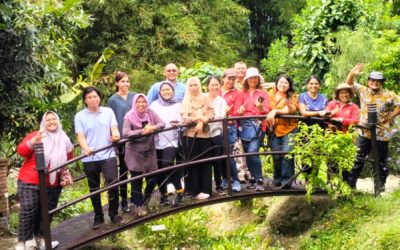Indonesia
270.2
Million inhabitants
190 456 900 ha
Country’s area
28 629 500 T
Palm oil exported in 2023
Indonesia
With over a century’s experience in the agricultural sector, Indonesia – the country of over 13 000 islands – is the world’s leading producer of palm oil and second largest producer of rubber.
Given Indonesia’s abundance of both renewable (agricultural products) and non-renewable (mines and minerals) resources, implementing long-term resource management is an imperative.
Agriculture has played a major role in the country’s development, and for centuries has been the most important source of employment. Indonesia currently has a production surplus on the domestic palm oil and rubber markets, and is a major exporter of raw materials.
- Palm oil
Oil palm cultivation has long been a traditional activity in Indonesia.
Today, palm plantations are operated as follows:
- around 55% by agro-industries ;
- 41% by village planters;
- 4% by parastatal companies.
This rather surprising distribution is explained by the implementation of the “Plasma Program”. The new large-scale industrial plantation projects (Inti) are obliged to develop, with financial support from the State and in parallel with their palm groves, oil palm plantations dedicated to local communities. The agro-industry is responsible for setting up the “plasma” plantation: from the nursery to the maturity of the palm trees (around 3 years). Then, as soon as the palms reach maturity, the palm grove is handed over to the village communities, who harvest and manage their plots. Finally, the sale of the harvest (fruit) enables them to reimburse the agro-industry for the investments previously made.
In Indonesia, palm oil is mainly destined for the food industry and for export. Considered one of the forerunners in the implementation of RSPO principles and criteria, the archipelago had 2 774 937 hectares of RSPO-certified oil palm plantations as of July 31, 2024.
- Rubber (rubber farming)
Indonesian rubber production comes mainly from village plantations (90%). Less than 6% comes from agro-industries and just over 4% from parastatal companies. In addition, a significant proportion of rubber is sold locally. These two characteristics totally distinguish Indonesian rubber farming from that of its African counterparts.
LINK
Latest news
PT Socfindo Serahkan Bantuan CSR bantu Ekonomi masyarakat di Nagan Raya
PT Socfin Indonesia (Socfindo) has distributed funds as part of its Corporate Social Responsibility (CSR) efforts in 2024 to support the local economy and reduce extreme poverty in the Nagan Raya region. The assistance, provided in the form of essential goods,...
134 Karyawan Socfindo Aek Pamienke Terima Jubilaris, Pengurus Sampaikan Apresiasi
134 employees of the PT Socfindo Aek Pamienke plantation, with 25 years' service, were awarded the Jubilaris prize at a ceremony. Erikson Ginting, Managing Director of PT Socfindo, presented the awards, underlining the company's appreciation for their dedication. The...
RSPO Secretariat and the Impact and Monitoring, Learning and Evaluation (IMEL) team visited Socfindo Conservation
The member of RSPO Secretariat and the Impact and Monitoring, Learning and Evaluation (IMEL) team visited Socfindo. The purpose of the visit is to understand how existing data needed in the metrics template are being collected on the ground and to understand the...

